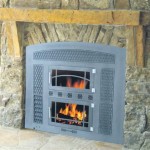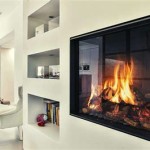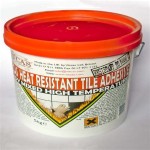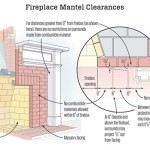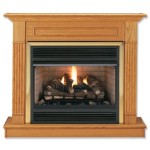Fireplace Surround Ideas For Stoves
The installation of a stove, whether wood-burning, gas, or electric, represents a significant enhancement to a home's heating capabilities and aesthetic appeal. However, the stove itself is only one element of a complete fireplace setup. The surround, encompassing the area immediately surrounding the stove, plays a pivotal role in defining the overall look, enhancing safety, and maximizing the stove’s functionality. Thoughtful consideration of surround materials, designs, and construction techniques is essential for achieving a harmonious and effective fireplace installation.
The primary purpose of a fireplace surround is to provide a non-combustible barrier between the stove and the surrounding wall. This barrier protects the wall from the intense heat generated by the stove, reducing the risk of fire. Additionally, a well-designed surround can improve the stove's efficiency by reflecting heat back into the room. From an aesthetic perspective, the surround serves as a visual frame for the stove, integrating it seamlessly into the room's decor. It allows for a wide range of stylistic expressions, from rustic and traditional to modern and minimalist.
The selection of materials for a fireplace surround is crucial and depends on factors such as the type of stove, the desired aesthetic, and budget constraints. Common materials include stone, brick, tile, metal, and wood (though wood requires careful treatment and adherence to safety regulations). Each material offers distinct advantages and disadvantages in terms of heat resistance, durability, cost, and aesthetic appeal. Careful evaluation of these factors is necessary to ensure the selection of the most appropriate material for the specific application.
Material Choices and Considerations
The choice of material for a fireplace surround significantly impacts the design and functionality of the fireplace as a whole. Each material possesses unique characteristics that should be carefully considered during the planning stage.
Stone: Stone surrounds offer a timeless and elegant aesthetic. Natural stone, such as granite, marble, limestone, and slate, provides exceptional heat resistance and durability. These materials can withstand high temperatures without cracking or warping, making them ideal for use with wood-burning stoves. The natural variations in color and texture of stone add visual interest and create a sense of authenticity. However, stone can be expensive and heavy, requiring professional installation. Faux stone, made from concrete or other composite materials, offers a more affordable alternative that mimics the look of natural stone. While faux stone is lighter and easier to install than natural stone, it may not offer the same level of heat resistance and durability.
Brick: Brick is a classic and versatile material for fireplace surrounds. Its inherent fire resistance and thermal mass make it a practical choice for wood-burning stoves. Brick also offers a rustic and charming aesthetic that complements a variety of architectural styles. Brick surrounds can be configured in various patterns and textures, adding visual interest to the fireplace. Like stone, brick is relatively heavy and requires professional installation. The cost of brick can vary depending on the type and quality of the brick used.
Tile: Tile is a popular choice for fireplace surrounds due to its versatility, affordability, and ease of maintenance. Ceramic, porcelain, and glass tiles are all suitable for use in fireplace surrounds. Tile offers a wide range of colors, patterns, and textures, allowing for endless design possibilities. Tile is also relatively easy to clean and maintain, making it a practical choice for busy households. However, tile is not as heat-resistant as stone or brick and may crack or chip under extreme heat. Therefore, it is crucial to select tiles that are specifically rated for use in fireplace surrounds.
Metal: Metal surrounds offer a sleek and modern aesthetic. Steel, cast iron, and copper are commonly used for metal surrounds. Metal is highly heat-resistant and durable, making it a suitable choice for wood-burning stoves. Metal surrounds can be customized with various finishes and textures, adding visual interest to the fireplace. However, metal can be expensive and may require specialized installation. Metal surrounds can also become very hot to the touch, so it is important to ensure that they are properly insulated or shielded.
Wood: Wood surrounds can add warmth and character to a fireplace. However, wood is a combustible material and must be treated with caution when used in proximity to a stove. Wood surrounds should be installed a safe distance from the stove and protected with a fire-retardant coating. It is essential to consult with local building codes and regulations to ensure that wood surrounds meet safety requirements. While solid wood offers a classic look, engineered wood products like MDF (medium-density fiberboard) or plywood can be used with a fire-resistant veneer to create a safe and stylish surround. The cost of wood can vary depending on the type and quality of the wood used.
Design Considerations and Styles
Beyond material selection, several design considerations play a critical role in creating a successful fireplace surround. These include the overall style of the surround, the size and shape of the stove, and the existing architectural features of the room.
Traditional Style: Traditional fireplace surrounds often feature ornate details, such as moldings, mantels, and decorative carvings. These surrounds typically incorporate materials like stone, brick, or wood, and are designed to complement classic architectural styles. Traditional surrounds often include a hearth, which is a non-combustible surface that extends out from the fireplace opening. The hearth provides a safe and functional space for placing firewood or other decorative items.
Modern Style: Modern fireplace surrounds tend to be minimalist and uncluttered, emphasizing clean lines and simple shapes. These surrounds often incorporate materials like metal, glass, or tile, and are designed to create a sleek and contemporary look. Modern surrounds may feature floating shelves or built-in storage, adding functionality to the fireplace. Color palettes are often neutral, with an emphasis on grays, whites, and blacks.
Rustic Style: Rustic fireplace surrounds evoke a sense of warmth, charm, and natural beauty. These surrounds typically incorporate materials like stone, brick, or reclaimed wood, and are designed to complement rustic architectural styles. Rustic surrounds often feature exposed brick or stone, adding texture and character to the fireplace. The use of natural elements, such as wood beams or stone accents, further enhances the rustic aesthetic.
Transitional Style: Transitional fireplace surrounds blend elements of traditional and modern design, creating a balanced and harmonious look. These surrounds often incorporate a mix of materials, such as stone and wood, and are designed to complement a variety of architectural styles. Transitional surrounds may feature clean lines and simple details, combined with traditional elements like moldings or mantels.
Size and Proportion: The size and proportion of the fireplace surround should be carefully considered in relation to the stove itself and the overall size of the room. A surround that is too small may look insignificant, while a surround that is too large may overpower the room. The surround should be sized to create a balanced and harmonious composition. The height of the surround should also be considered, as it can affect the perceived height of the room.
Installation and Safety Considerations
Proper installation is paramount to ensure the safety and functionality of a fireplace surround. Installation procedures will vary depending on the type of material used and the specific design of the surround. It is highly recommended to consult with a qualified professional to ensure that the installation is performed correctly and in accordance with local building codes and regulations.
Clearances: Maintaining proper clearances between the stove and the surrounding wall is crucial for preventing fires. Building codes typically specify minimum clearances for combustible materials, such as wood, drywall, and wallpaper. These clearances must be strictly adhered to in order to ensure the safety of the installation. The stove manufacturer's instructions will also provide specific clearance requirements for the stove. Failure to maintain proper clearances can result in a fire hazard.
Non-Combustible Materials: The materials used for the fireplace surround must be non-combustible or protected with a fire-retardant coating. Non-combustible materials, such as stone, brick, tile, and metal, will not burn or contribute to a fire. Combustible materials, such as wood, must be treated with a fire-retardant coating to reduce their flammability. The fire-retardant coating should be applied according to the manufacturer's instructions.
Ventilation: Proper ventilation is essential for ensuring the safe and efficient operation of a stove. The fireplace surround should not obstruct the stove's vents or air inlets. Obstructions can reduce the stove's efficiency and increase the risk of carbon monoxide poisoning. The stove manufacturer's instructions will provide specific ventilation requirements for the stove.
Professional Installation: While some homeowners may be tempted to install a fireplace surround themselves, it is highly recommended to hire a qualified professional. A professional installer will have the knowledge, skills, and experience necessary to perform the installation correctly and safely. A professional installer will also be familiar with local building codes and regulations, ensuring that the installation meets all applicable requirements.
By carefully considering these material, design, and installation considerations, homeowners can create a fireplace surround that is both aesthetically pleasing and functionally safe, enhancing the enjoyment and value of their home.

Amazing Log Burner Fireplace Surround Ideas Direct Stoves

4 Fireplace Hearth Ideas Arada Stoves

Amazing Log Burner Fireplace Surround Ideas Direct Stoves

Brick Fireplace Design Installation Scarlett Fireplaces

Fireplace Surrounds Burning Inspirations

Fireplace Surrounds For Stoves Fireplaces Are Us

Inspiring Fireplace Surround Tile Ideas To Reflect Your Unique Vision Wood Burning Stoves Living Room Home House Design

How To Decorate Around A Wood Stove Rustic Crafts Diy

Amazing Log Burner Fireplace Surround Ideas Direct Stoves

Wood Burning Hearth Ideas Google Search Fireplace Surrounds Stoves Living Room Modern

